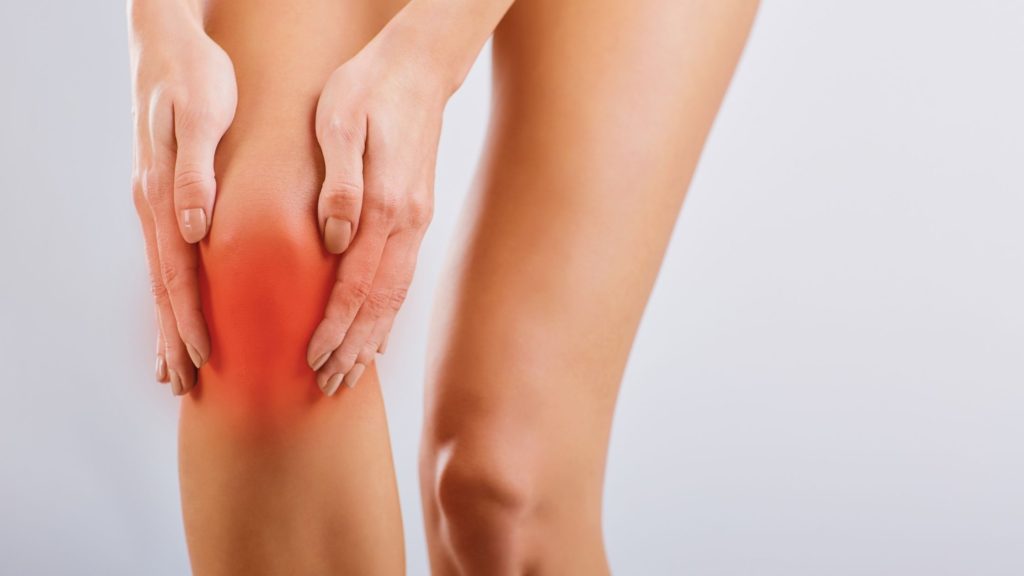Last updated on March 17th, 2025 at 05:36 pm
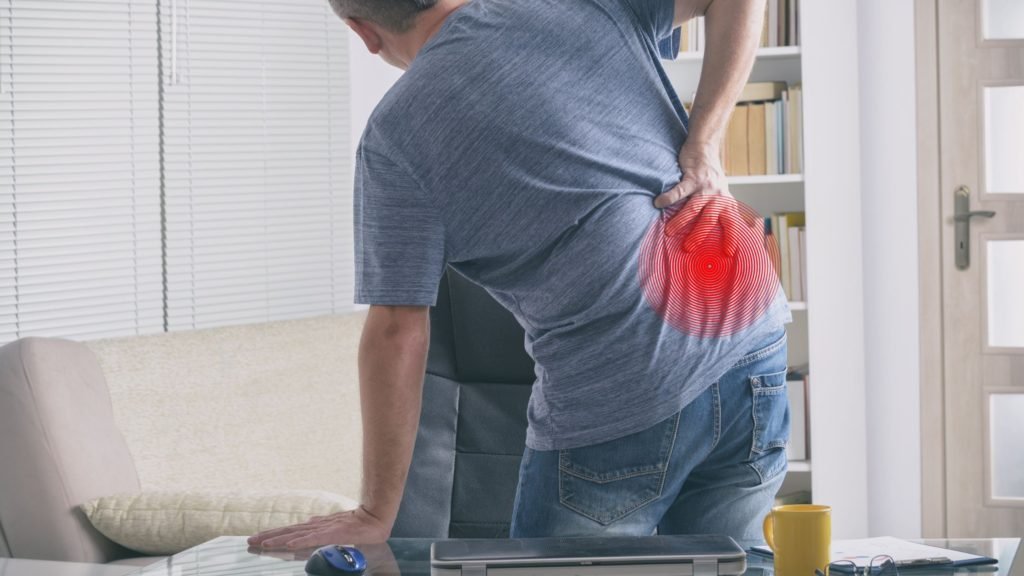
If you are experiencing a persistent, shooting pain that starts in your hips and shoots down your legs every time you stand up or take a step, then chances are you have a painful condition known as sciatica.
Sciatica is a condition that affects millions of people worldwide. However, there is strong research evidence1 that simple core strengthening exercises for sciatica can relieve the pain and regain your mobility.
In this article, we’ll go over some effective exercises that can help you manage your sciatica symptoms and improve your quality of life.
Easy exercises for the sciatica pain relief
Exercise is crucial in the management and prevention of sciatica. The exercises we are going to learn are aimed to improve flexibility and strength. Actually, sciatica is a condition in which the sciatic nerve that originates from the low back and supplies to the leg gets pinched at the lower back region.
Exercise helps to alleviate pressure on the sciatic nerve and reduce the risk of further injury or aggravation1. Additionally, exercise can help improve blood flow and oxygenation to the affected area, which can help promote healing and reduce inflammation.
Incorporating exercises such as the prone leg and hand raise, quadruped leg raise, cat-camel stretch, and sciatica stretching exercise into your daily routine can help alleviate pain and discomfort associated with sciatica.
However, we strongly recommend that exercise should be done under the guidance of a physiotherapist.
1) Bridging exercise for sciatica pain relief
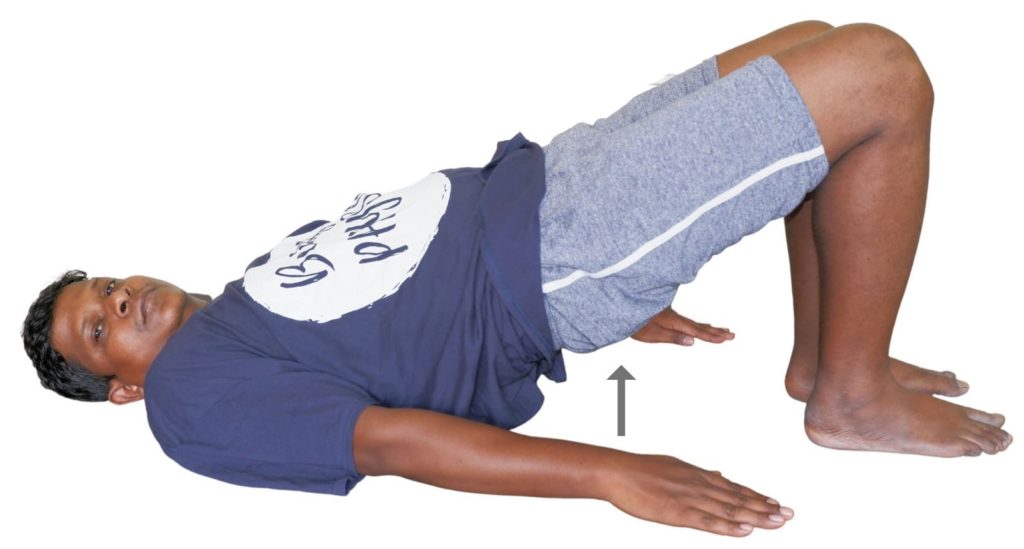
The first exercise is the bridging exercise. The purpose of this exercise is to strengthen the muscles in the lower back and buttocks, which can become weak because of inactivity due to sciatica pain.
Strengthening these muscles helps alleviate pressure on the sciatic nerve, reduce inflammation and improve their overall range of motion.
- To perform the bridging exercise your starting position would be lying down on your back with your knees bent and feet flat on the floor. Keep your arms by your sides with your palms facing down.
- Then, slowly lift your hips off the ground by pushing through your feet and contracting your glutes and hamstrings. Lift it as high as possible.
- Hold this position for 5 seconds and then lower your hips back down to the ground.
- Repeat this movement for 10 to 15 repetitions.
It is important to note that if you have too much sciatica pain, you should start with a low number of repetitions and gradually increase as you feel comfortable.
2) Chest raise in prone
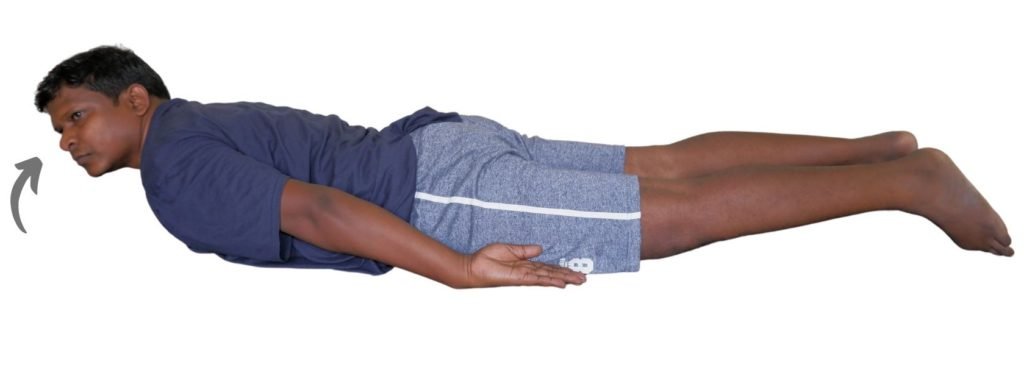
Our next exercise for sciatica relief is chest raise in prone. This exercise is also aimed to strengthen the muscles in the lower back. To perform this exercise:
- Start by lying on your stomach with your hands resting at your sides.
- Now, slowly and smoothly raise your upper body off the ground, keeping your hips and legs on the floor. Lift it as high as possible.
- Hold this position for five seconds, and then slowly lower your upper body down. While doing so, inhale as you raise your chest and exhale as you lower it back down.
- Repeat this exercise for a minimum of 10 to 15 repetitions, focusing on contracting the muscles in your lower back as you raise your upper body off the ground.
3) Leg raise in prone to strengthen low back muscle in sciatica
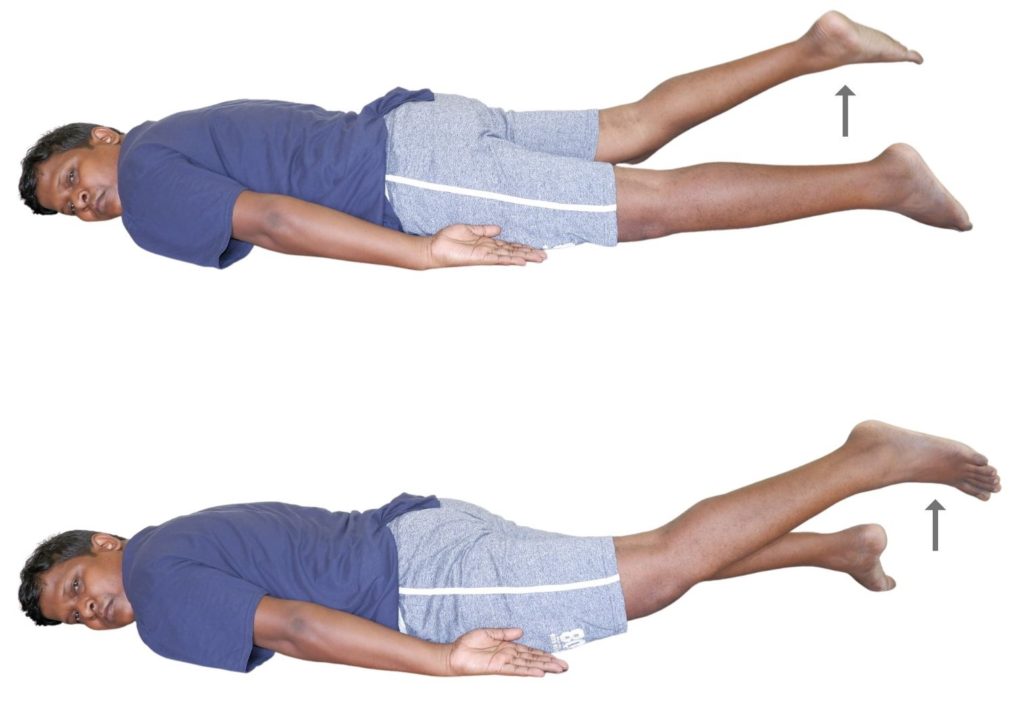
The third exercise is the leg raise in a prone. It is another effective way to strengthen the lower back muscles and relieve sciatica pain.
- The starting position of this exercise would be the same as the previous one, ie, lying on your stomach with your hands by your sides.
- Now, begin by lifting one leg straight up while keeping the knee straight, and hold it for 5 seconds.
- Then slowly lower the leg back down and repeat the same process with the other leg.
- Keep in the mind that leg should be straight throughout the exercise to maximize its effectiveness.
- Repeat this exercise on each leg for 10 repetitions, or as many as you can comfortably do.
The leg raise in prone exercise helps to strengthen the muscles of the lower back, buttocks, and hips, which can help alleviate pressure on the sciatic nerve and reduce pain.
4) Leg and hand raise in prone
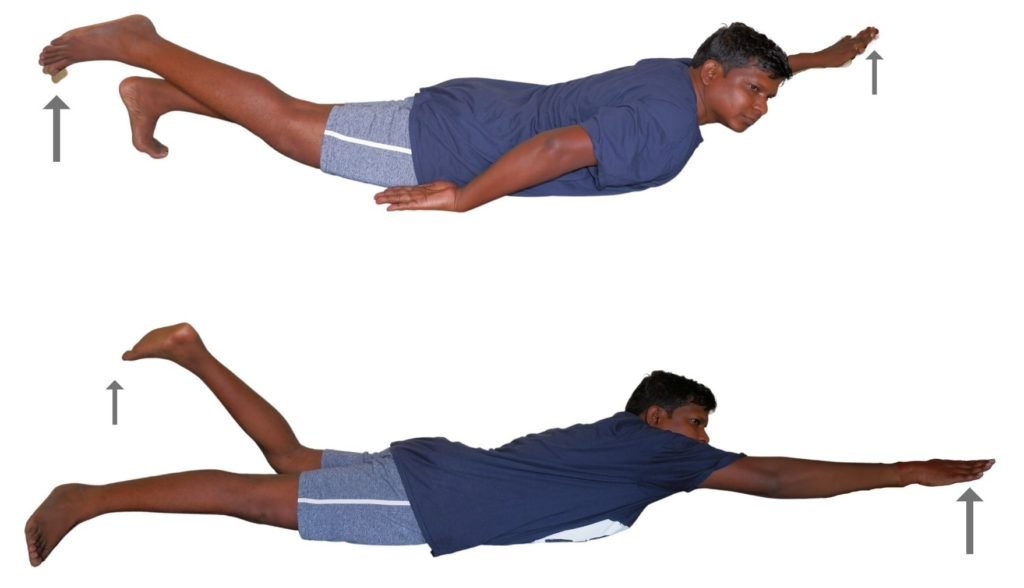
The leg and hand raise in prone is the next exercise. To perform this exercise:
- Start by lying on your stomach with your hands resting on the ground next to your shoulders.
- Lift one leg and the opposite arm off the ground at the same time, making sure to keep them straight.
- For example, if you lift your right leg, also lift your left arm at the same time.
- Hold this position for 5 seconds, then lower your leg and arm back down to the ground.
- Repeat this movement with the other leg and arm.
- This exercise should be performed for 10 repetitions on each side.
By lifting one leg and the opposite arm off the ground, this exercise helps to engage and strengthen the core muscles, particularly those in the lower back.
It also works to improve balance and coordination, which can be helpful for those experiencing sciatica-related pain or discomfort while walking or standing.
5) Leg and hand raise in quadruped
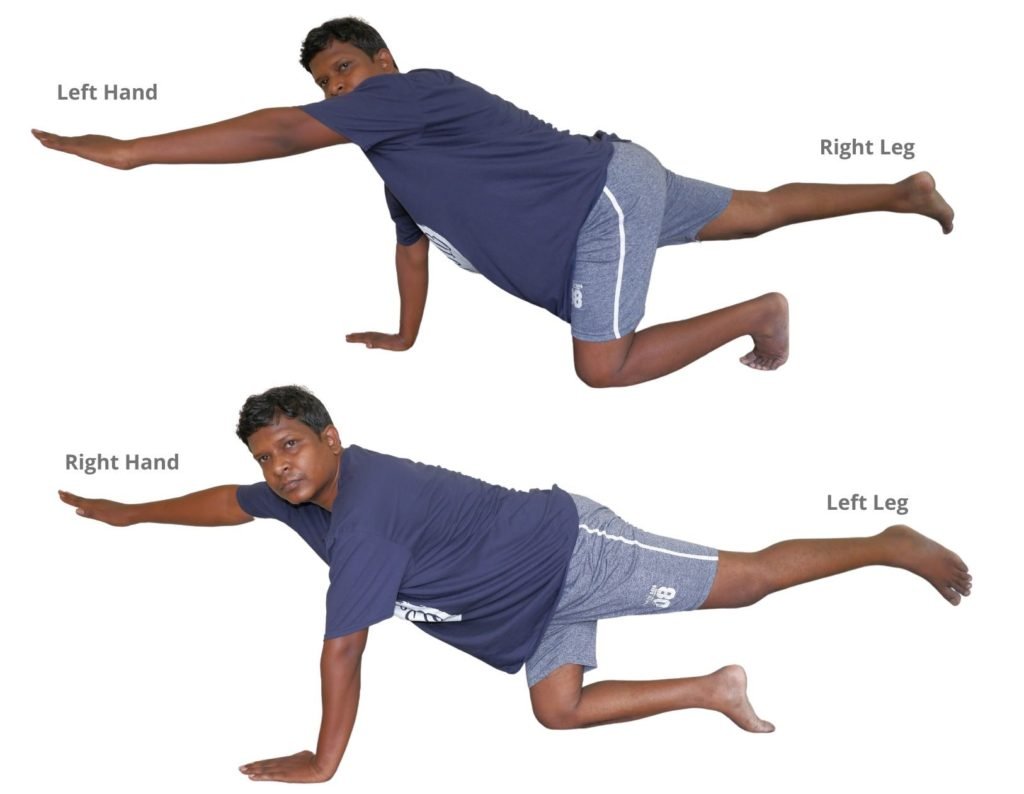
Our next exercise is leg raise in quadruped, which is performed in quadruped position.
- For the quadruped position, keep your hands and knees with your hands placed directly under your shoulders and your knees directly under your hips. Keep your back flat and your neck in line with your spine.
- In this position, lift one leg and the opposite hand off the ground and extend it as straight as possible. Keep your hand and knee straight and your foot flexed.
- Hold this position for 5 seconds, and then lower your leg back down to the starting position.
- Repeat with the other leg.
- Alternate between legs for a total of 10 repetitions on each side. If you find it difficult to balance, try placing a yoga block or a cushion under your supporting knee to provide some extra stability.
- Remember to engage your core muscles throughout the exercise to protect your lower back and maximize the benefits.
This exercise not only helps to alleviate sciatica pain but also strengthens the muscles in your lower back, hips, and legs. This can improve your overall posture, reduce the risk of future injuries, and make everyday activities like walking, standing, and sitting more comfortable.
6) Cat camel exercise for sciatica treatment

The cat and camel exercise is also effective for sciatica aimed to stretch and mobilise the lower back. It also strengthens the core muscle.
This exercise is also performed in the quadruped position.
- So, in quadruped position take a deep breath and arch your back downwards by lifting your head towards the ceiling. This is the “cat” position.
- Hold this position for a few seconds, feeling the stretch in your spine.
- Next, exhale and reverse the movement by lowering your head towards the ground and arching your back upwards. This we term the “camel” position.
- Again, hold this position for a few seconds, feeling the stretch in your spine.
- Repeat this movement back and forth between the cat and camel positions for several repetitions.
7) Sciatica stretching exercise
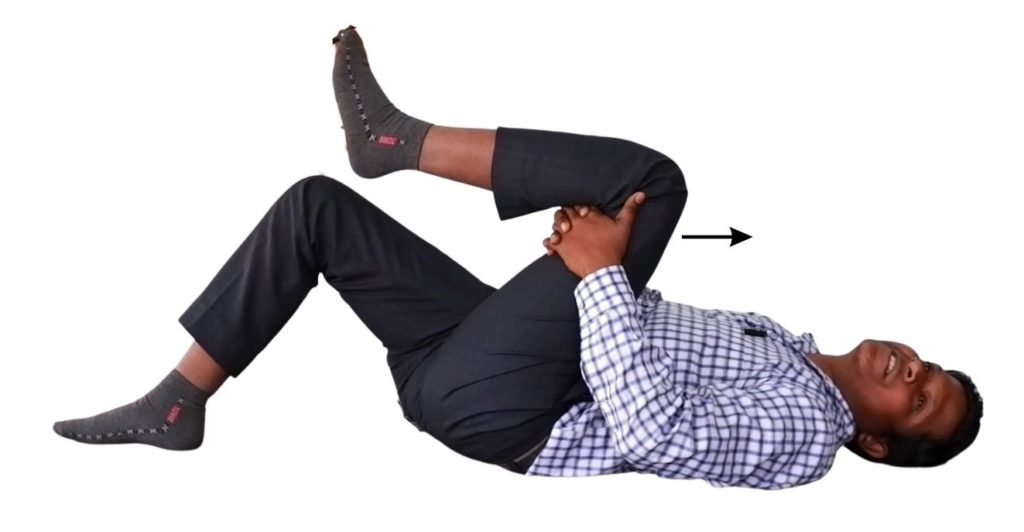
Lastly, there is the sciatica stretching exercise. There are other few good sciatica stretching exercises, but here I am going to demonstrate one of them.
For another stretching exercise, you should refer to this article “4 Easy Stretching Exercises For Sciatica For Instant Pain Relief“.
For this exercise:
- Lie down on your back with your knees bent and feet flat on the floor. If your sciatica pain is on your left leg, lift your left leg off the floor and hold the back of your thigh with both hands.
- Now, gently pull your left leg towards your chest until you feel a stretch in your lower back and buttock area. You should feel the stretch on the side of the leg that is affected by sciatica.
- Hold this position for 30 seconds while maintaining deep, slow breaths. Slowly release the stretch and lower your left leg back down to the floor.
- Rest for a few seconds before repeating the stretch 3 to 4 times.
Lifestyle modification with sciatica
By doing these exercises twice a day, once in the morning and once in the evening, you will see that your sciatica pain will slowly reduce.
However, it is recommended that you also visit your nearest physiotherapist for manual therapy, traction to your spine, and TENS therapy for faster recovery. Combining these exercises with physiotherapy for sciatica will be even more effective2.
In addition to this, you must take care of some daily activities that when performed in a wrong manner can exaggerate the sciatica pain. This includes a proper way of getting out of bed in sciatica and the best sleeping position in sciatica pain.
We also strongly recommend the use of a lumbar belt/back pain belt until your pain is normalised. The Lumbar belt gives support and protection to your lower back preventing further pinching of the sciatic nerve.
However, you must know how to choose the correct size of back pain belt that fits your lower back for more effect. With this small precaution, you are sure to get out of this debilitating pain.
Keep Reading: Buttock Pain When Sitting? TENS & Other Tips For Piriformis Syndrome
The author is a physiotherapist who has been practising for the last 17 years. He holds a Bachelor's in Physiotherapy (BPT) from SVNIRTAR (Swami Vivekananda National Institute of Rehabilitation and Research), one of the prestigious physiotherapy schools in India.
Whatever he learns dealing with his patient, he shares it with the world through blogs and e-books. He also owns a YouTube channel, "Sunit Physiotherapist" with over 8 lakh active subscribers. Here, he shares everything he gets to learn serving the patient.





